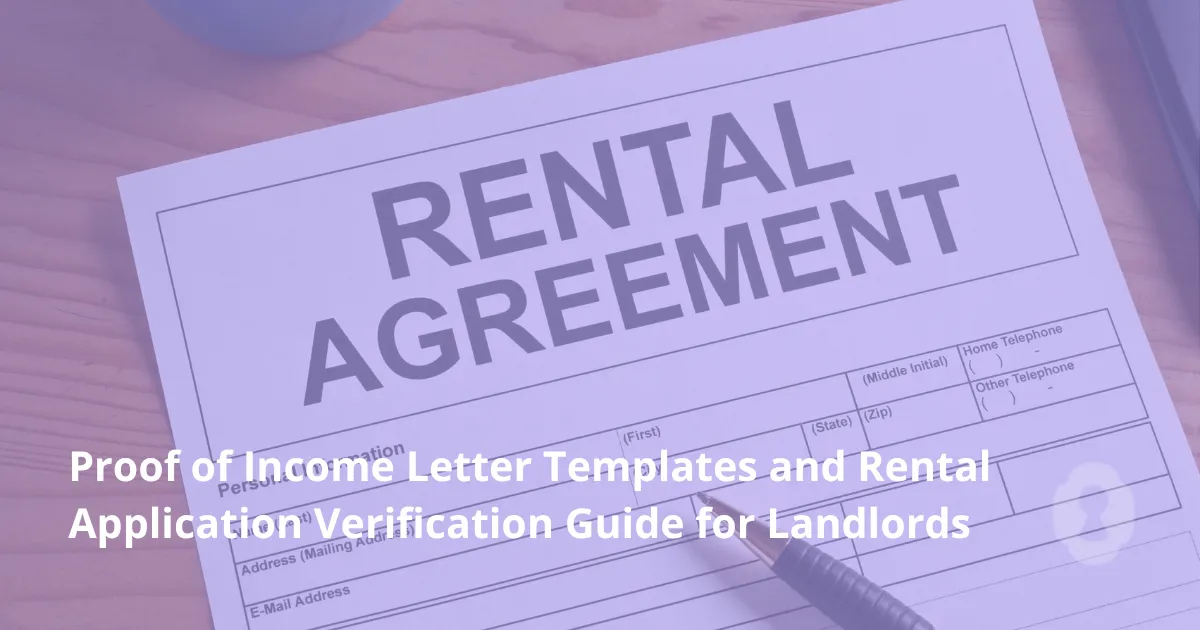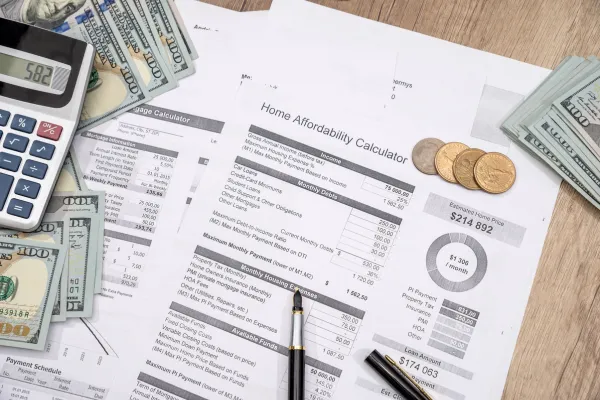
Did you know that nearly 30% of rental applications get rejected because of missing income proof?

This shows how important proof of income letters are in renting out a place. As a landlord, checking a potential tenant's income and job is key to getting rent on time.
A proof of income letter proves a tenant's income and job, giving landlords the confidence to say yes to a rental. Using a proof of income template makes this check easier. It helps landlords see if a tenant is reliable.
"Income verification isn't just about confirming a tenant can pay rent today—it's about predicting their ability to sustain payments throughout the entire lease term. The most effective property managers look beyond the standard 3x income rule to understand a tenant's complete financial story, including seasonal fluctuations, career trajectory, and debt-to-income ratio. This holistic approach transforms income verification from a simple checkbox into a meaningful assessment of long-term housing stability. When done with care and transparency, this process actually benefits both parties—giving landlords confidence in their investment while helping tenants avoid committing to housing that could become a financial strain."
Taylor Wilson, CEO of Rent with Clara
As a landlord, checking a tenant's income is key to keeping your investment safe. It ensures they can pay rent on time, avoiding financial losses.
Checking a tenant's income is vital for your investment. It confirms their financial stability, lowering the chance of missed payments. This is good for your cash flow and investment success.
"A thorough income verification process is a landlord's best defense against potential financial losses." It's a smart move for the long-term success of your rental property.
Landlords must follow the law when checking tenant income. This means sticking to fair housing laws and not discriminating based on income or other protected traits.

The 3x rent income rule is a common guideline for landlords. It says a tenant's income should be at least three times the monthly rent.
This rule helps landlords see if a tenant can afford rent and other expenses. But, it's also important to look at credit history and debt to understand their financial situation fully.
By checking tenant income and using the 3x rule, landlords can make smart choices. This protects their investment and helps build a good relationship with tenants.
To check if a tenant can pay rent, landlords ask for different income proof. These documents help figure out if the tenant can handle the rent and other costs of the property.
Pay stubs and salary statements are key for income verification. They show how much an employee makes, what's taken out, and what's left. Landlords should check if the income is steady and enough to pay the rent.
Bank statements give a full picture of a tenant's finances. They show income, account balances, and regular transactions. Landlords can see if the tenant has a steady income and enough money for rent.
Key information to look for in bank statements:
Tax returns and W-2 forms are vital for income verification, mainly for self-employed or those with complex finances. They show a tenant's yearly income and tax duties.
"Tax returns and W-2 forms offer a detailed picture of a tenant's income, helping landlords make informed decisions about their rental applications."
Employment verification letters confirm a tenant's job, income, and work history. They're helpful for those with variable pay or new jobs.
When asking for an employment verification letter, landlords should make sure it includes:
Landlords and property managers need to establish clear standards for acceptable income documentation to streamline their screening process. Standard documents that demonstrate consistent income include recent pay stubs (typically within 30 days), official bank statements showing regular deposits, and tax returns for self-employed individuals.
However, not all paperwork qualifies - handwritten notes, unofficial printouts, or outdated statements from over 60 days ago won't sufficiently verify your income or prove your ability to pay rent.
When evaluating sources of income, experienced property owners look for documentation that shows stable income patterns rather than one-time payments or irregular deposits. A letter from your employer on company letterhead, recent W-2 forms, and official benefit statements all serve as reliable supporting documents.
For tenants with multiple income streams, combining several types of verification helps paint a complete picture of their overall income and income level.
A well-structured proof of income template is key for landlords. It helps verify if a tenant can afford the rent. We'll look at what makes up a good template.
The basic structure of a proof of income template should include key information about the tenant's employment and income.
A typical proof of income letter includes the tenant's full name, job title, company name, employer's contact information, hire date, current salary or hourly wage, hours worked per week, and a statement confirming employment.

The template must capture essential details to verify the tenant's income effectively.
The following fields are necessary:
Landlords can customize the template according to their specific needs.
Customization may include adding fields for additional income sources or modifying the layout for better clarity. For instance, a landlord might want to include space for noting any variable income, such as commissions or bonuses.
For more information on proof of income letters, you can visit https://www.leaserunner.com/blog/proof-of-income-letter.
By following these guidelines, landlords can create an effective proof of income template. This helps in making informed decisions about potential tenants.
Tenants who need to write a proof of income letter should focus on creating a professional document that clearly demonstrates their average monthly income and employment stability. A well-written proof of income letter includes your full name, current position, employer contact information, hire date, and specific salary details.
The letter helps establish credibility when standard pay stubs aren't available, particularly for new employees or those with variable compensation structures.
Your income letter for the apartment should be concise yet comprehensive, typically including a statement like "please feel free to contact me at [phone number] to verify the information provided." This personal touch shows transparency and gives landlords confidence in your application.
Remember that this letter is an official document that will be used to assess your income and credit worthiness, so accuracy is crucial for successfully applying for an apartment.
Some prospective tenants may legitimately struggle to meet your income verification requirements through standard documentation, particularly new employees, recent graduates, or workers transitioning between jobs. While landlords often require proof of income within the first few days of application, certain situations call for flexibility in what documents count as proof of income.
For instance, a newly hired employee might need a proof of income letter from their HR department confirming their start date and salary, even without recent pay stubs, or someone between jobs might provide a signed employment contract along with bank statements showing their current income reserves.
When landlords request proof of income from tenants facing documentation challenges, alternative approaches can still demonstrate the tenant's ability to pay rent effectively. An income letter is a document that can bridge gaps when traditional paperwork isn't available - such as a detailed letter from a CPA for freelancers, court-ordered support payment documentation, or benefit award letters combined with bank statements.
The key is ensuring that any alternative documentation provides verifiable information about the applicant's financial capacity, whether through professional references, official government correspondence, or financial institution records that demonstrate consistent income patterns over recent months.
Verifying income for traditional W-2 employees is crucial. It helps landlords check if potential tenants can pay rent on time. This process involves several important steps.
One key way to verify income is by looking at pay stubs. Pay stubs show how much an employee earns, what's taken out, and their net pay. Landlords should check if the income is steady, verify the employer's details, and watch for any odd pay amounts or schedules.
It's best to ask for pay stubs from the last few months. This gives a clear view of the tenant's current earnings.
Employer Verification Process
Checking with the employer directly adds more confidence. This can be done by calling the HR department or using a service for employment verification. The employer verification process confirms the tenant's job, employment dates, and salary. It makes sure the pay stub info is correct.
To understand a tenant's total income, landlords must calculate their annual income. This is done by multiplying the monthly income by 12. It's also key to include any bonuses, commissions, or overtime pay.
By doing this, landlords can see if the tenant meets the 3x rent rule. This rule says the tenant's income should be at least three times the monthly rent.
Some tenants have more than one job or income source. Landlords need to check each one. This might mean getting pay stubs from different employers, looking at bank statements, or reviewing tax returns.
By looking at all income sources, landlords can get a full picture of the tenant's finances.
Landlords need to think differently when renting to self-employed people. These individuals don't have steady paychecks like regular employees. Their income can change a lot and is harder to check.
To check self-employed tenants' income, landlords can look at different documents.
These might include:
It's important to ask for many documents to really understand the tenant's money situation.
Checking if a self-employed tenant's business income is stable is key.
Landlords should look for:
As one expert says,
"A stable business income means the tenant can pay rent on time."
Profit and loss statements give a detailed look at a self-employed tenant's business money.
When looking at these, landlords should:
When checking self-employed tenants' income, there are warning signs landlords should watch out for.
These include:
Being careful about these warning signs can help landlords avoid problems.
Landlords often deal with tenants who have non-traditional income. This includes government benefits, retirement income, investment income, and alimony. These income types need a special approach when checking.
Government benefits like Social Security, disability benefits, and housing assistance are stable for tenants. To check these, landlords can ask for documents from the government or bank statements showing regular deposits.
Retirement income, like pensions and retirement account distributions, offers a steady income. Landlords should look at financial documents to verify this income.
This includes:
Tenants with investment or rental income have a more complex financial situation. Landlords should check the stability of this income.
They can review:
Alimony and child support are also considered income. But, landlords must verify the regularity and length of these payments.
Tenants should provide:
By carefully checking these non-traditional income sources, landlords can make better decisions about tenant applications.
Digital tools have changed how landlords check tenant income. Online services and software make it faster and less error-prone. But, it's important to think about the security and privacy of these tools.
Online services make it easier for landlords to check income. They let landlords ask for income proof online. This makes the process smoother and cuts down fraud risks.
For example, SingleKey provides detailed income verification tools. They work well with rental apps.
Landlords can use software to manage their properties, including income checks. These tools help with online payments, lease management, and tenant screening. They make managing properties more efficient.
Some software solutions include income verification in their features. This helps landlords handle tasks better.
Security and privacy are key when using digital tools for income checks. Landlords must follow data protection laws like GDPR or CCPA. They should also use secure data transmission and storage.
Handling tenants' personal and financial info carefully is crucial. It builds trust and follows legal rules.
Landlords should have a clear income verification process. They should list what documents are needed and when. Using the same criteria for everyone helps avoid discrimination claims.
Having a standard process also helps manage expectations. It makes the rental application process smoother.
Using digital tools and following best practices makes income verification better. It's faster, safer, and more reliable. This benefits both landlords and tenants by making the process clear and fair.
Smart property managers typically request proof of income early in the application process, usually after an initial showing but before conducting expensive background checks. This timing helps renters understand expectations upfront while allowing landlords to ask for proof of income before investing time in unqualified candidates.
Most successful landlords request that applicants provide proof of their income details within 48-72 hours of submitting their initial application.
The key to effective income verification lies in clear communication about what constitutes acceptable proof of employment and income history. Property owners should specify whether they need additional proof beyond standard documentation, especially for applicants with supplemental security income or non-traditional employment.
When you show proof of income requirements upfront, it eliminates confusion and helps qualified tenants prepare the right documents that show their financial stability.
Checking a tenant's income is key in the rental process. It helps landlords see if the tenant can pay rent on time. Using a proof of income template makes this easier.
A good proof of income letter shows a tenant's financial health. It includes different kinds of income and job details. This helps landlords decide if a tenant is right for the property.
Checking income helps landlords avoid risks. It shows the tenant is financially stable and trustworthy. By using digital tools, landlords can make sure the process is smooth and safe.